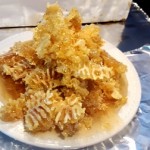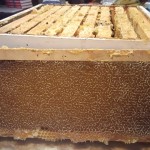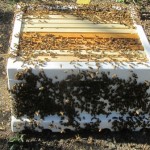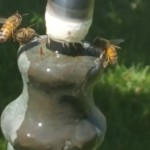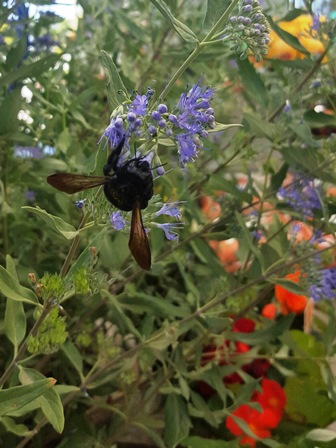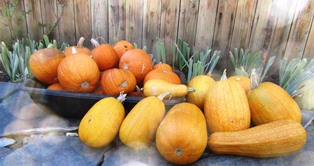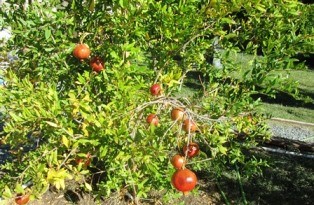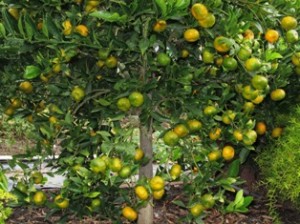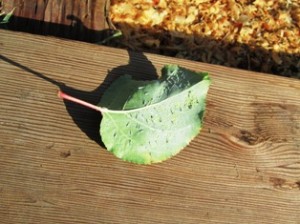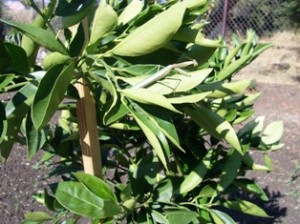Checklist for Bay Area Fruit Trees
In the Bay Area, January through February are optimal months for checking on your backyard fruit trees. After the leaves have dropped and the scaffolding is exposed, winter/early spring pruning is a lot easier.
The first months of the year are also the best times to feed, do orchard cleaning, and deal with overwintering pests.
Citrus trees, especially, benefit from a mid-winter check for magnesium or iron deficiency, indicated by yellowing of the leaves. You should also examine the trees for pests such as snails, ants, aphids and Leafminer. It’s also a good time to plan on how to protect your citrus against frost.
Handy Checklist
- Prune apples and pears for structure in late winter or early spring. Check for fire blight (look for a shepherd’s hook and the appearance of fire staining on limbs and the trunk). Remove wood 8-12 inches below infected areas and any obvious cankers. Feed when the trees leaf out.
- Check almonds, apricots, cherries, and plums for pests such as aphids, scale. Treat as necessary. Instead of pruning apricot and cherry trees in mid- to late winter, wait for late summer/early fall as winter rains can spread infections of Eutypa fungus that causes limbs to die back.
- Practice ongoing winter cleanup. Sanitation is of paramount importance in preventing pests infestations and fungal diseases. Regularly move fallen leaves, twigs, fruit, and other debris from the garden and orchard.
- Check citrus for infestation of Citrus Leafminer (look for brown lines and webbing on the leaves along with curling of the leaves. Treat the tree with Captain Jack’s organic fruit and vegetable spray. Application needs to be repeated every two weeks, especially when the tree is producing new growth, but no more than six times per season.
- Citrus leaves that are yellow or mottled with yellow when they should be bright green may have a magnesium or iron deficiency. Correct the chlorosis by applying iron. Prune citrus in mid-to-late March (here in the Bay Area).
___________________________________________________
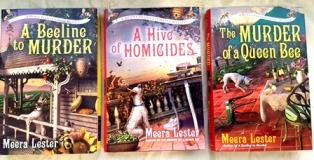
Enjoy reading about farm topics? Check out my Henny Penny Farmette series of cozy mysteries. Chocked full of farm trivia and helpful advice for keeping chickens and bees and growing heirloom fruit and vegetables, all three novels are available online at Amazon and Barnes and Noble bookstores and in brick-and-mortar stores everywhere books are sold.
How to Grow Garlic
In the Bay Area, September to late October is the optimum time to sow garlic for a spring harvest. Or, you can plant garlic in prepared beds in spring for an autumn harvest.
Get your garlic cloves into garden soil or containers before the first frost to ensure enough time during the rainy winter months for the bulb to grow. Watch for the appearance of its strap-shaped leaves.

Why Grow Garlic?
Garlic is an ancient herb that adds a wonderful pungent complexity to a wide variety of culinary creations. In a kitchen garden, vegetable patch, or potager garden where herbs and vegetables grow alongside berries and fruit trees, garlic works as a beneficial companion plant because its pungent odor acts as repellent for many common garden pests.
Garlic has medical uses, too. In many parts of the world, the herb has been used as treatment for hypertension, bronchial inflammation, fungal skin issues, and high cholesterol. Modern science makes note of garlic compounds as having anti-inflammatory, anti-fungal, and anti-bacterial properties as well as benefiting the immune system.
Choose Softneck or Hardneck Garlic
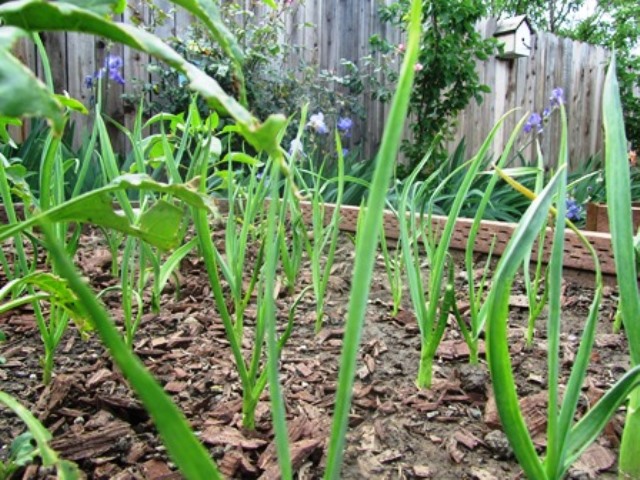
Garlic falls into two main types: the shorter, softneck variety and the long hardneck type that is often braided. Gardeners can choose from dozen of varieties in each type. Local DIY garden centers or nurseries generally offer garlic during the optimal times for planting it. Notably, elephant garlic, while bearing the name of garlic, is not garlic at all but rather a relative of the leek family whereas true garlic is related to the onion (Allium) family.
Following the following six simple tips can ensure success at growing garlic as a kitchen staple.
- Plant each clove (pointed side upward, round base downward) in full sun, about 4 inches deep and 4 to 6 inches apart. Space the rows 6 to 8 inches apart. Use well drained-loamy soil to grow your garlic.
- Grow the garlic in raised beds with soil amended with compost and fertilizer if you have clay soil since clay is unsuitable for growing garlic. The point is to plant this herb in a nutrient-rich, well draining but moisture-retentive soil.
- Water well when planting; do a weekly watering thereafter. For autumn planting, the Bay Area’s rainy season might provide enough water to keep the herb happy without extra watering through winter, but it’s no guarantee. Drought conditions have prevailed through the rainy season of past years and then there were 17 atmospheric river storms in 2022-2023. Your best bet is to keep checking on the garlic until it is well established.
- Harvest any garlic scapes, the long, green flowering stems of hard-neck garlic, before they flower. The garlic bulbs will be significantly smaller if the scapes are permitted to flower.
- Control weeds. If allowed to grow, they can take over your garlic plants.
- Keep an eye out for pests like dry bulb mites (watch for stunted, twisted leaves and galls indicating that these wormlike pests are present). Other pests include leaf-miners, parasitic wasps, and garlic bloat nematodes (roundworms that feed on the plant, rendering the bulbs soft, brown, and unusable).
Enjoy reading about gardening and other country-living topics, check out my cozy mystery novels. They are chocked full of tips on gardening, beekeeping, and country cooking as well as offering a great mystery in the style of Agatha Christie.
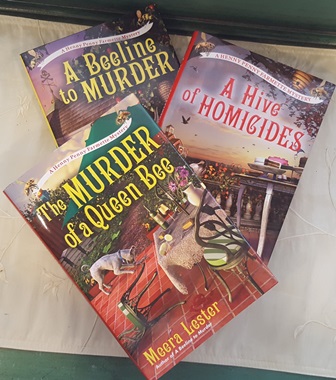
Autumn Brings A Honey Harvest and Hive Treatment
Harvesting sweet-tasting, amber-colored honey from my hives has become an autumn ritual. This past Sunday, my beekeeper neighbor and I opened, inspected, and removed ten frames of honey from the one hive I have left.
The other hive succumbed to stress, a hive beetle infestation, and a steady march of ants. This despite me keeping my hives (and the apiary) pristine, dry, and facing the sun.
I found a beetle (no larvae) in the super we removed from the hive box when I scraped the frames clean of wax and bee glue. The tiny black insect had established itself in a crack under a plug of wax. Bees can’t sting through the beetle’s hard shell.
Without a powerful way of combating an infestation of beetles, the hive becomes stressed.Thank goodness, my neighbor had just the treatment to eliminate any other unseen beetles from my hive box.
Beetle Bee Gone sheets are an all natural and chemical-free method for treating hive beetle. Bees munch on the sheet that then becomes a fuzzy trap that ensnares the beetles. The beetles die.
In cool weather, which is what we have now, the hive beetle moves to the interior, above the brood, and/or under the hive cover. When the weather gets warmer, the pests move downward and so the placement of the sheets must be moved down.
My neighbor also inserted under the hive box lid a small plastic trough (as long as a pencil) with holes. He poured vegetable oil into the trough until it was half full. This, too, is a natural treatment against the hive beetle. The pests drown.
I’m optimistic that these treatments (along with others I’m using for mites) will keep the hive protected over winter so that in spring, I’ll get a new swarm to grow my diminished colony.
With the bees tended to, I turned my attention to the honey harvest. In all, the single super of ten frames produced roughly three gallons of honey once I’d prepped the frames and put them in the extractor. That’s more than enough honey to get my family through the winter and to present as gifts to friends along with jars of fruit jams and homemade sweets come Christmas.
_________________________________________________________________
If you enjoy reading about backyard beekeeping, caring for chickens, or growing organic vegetables, check out my Henny Penny Farmette series of books. All are available through traditional and online bookstores. To see more, click on the link.
A Hive of Homicides or Hive Demise
The title of the third novel in my Henny Penny Farmette series suggests loss of bees and murderous intent. No beekeeper wants to lose a hive, regardless of how it happens–whether some invader wants to kill the bees, go after the honey, or use the hive as a host for proliferation of its own species.
I’m not one-hundred percent positive why I lost a hive this year. My best guess was that the demise was due (not to homicide but rather) to a tiny little pest, possibly a beetle that weakened it so that the bees and queen fled leading to the hive’s demise.
My beekeeper neighbor and I spotted a small beetle and treated for it. My best efforts to keep my small bee house and the area around it clean as well as doing frequent hive inspections wasn’t enough. Now, I’m considering moving my remaining hive onto a higher, drier, sunnier location.
I’ll do it at night which is the correct time to move bees. You just put a little strip of packing foam along the hive entrance, gently move the hive, and place it in the new location. Remove the foam strip so the bees can leave at dawn and make sure there’s a water source nearby.
The bees will likely accept the move if there is water and food in the area. I like planting perennial bee gardens and flowers and bulbs with high nectar value for bloom throughout the year.
Since hives can be compromised by wax moths, hive beetles, and other pests (as well as parasites and diseases), frequent inspections to decipher a problem and treat it before it destroys your hive is imperative.
With supers (smaller hive boxes with ten frames each) on the hive in June, the bees will forage on abundant flowers and produce honey that can be taken off in July. That’s also the time to inspect for mites because these populations tend to swell during summer.
________________________________________________________________
If you’re interested in beekeeping and other farmette topics, check out my Henny Penny Farmette series of mysteries. All are available to order online at Amazon, Barnes and Noble, and other retailer sites as well as traditional bookstores everywhere.
Beauty in the Garden–Butterflies and Other Pollinators
I enjoyed studying botany and zoology in school, but never felt attracted to the study of butterflies, bees, beetles, and bugs with any kind of intensity. I regret that. Not only because some of these pollinators are beautiful, but many are also beneficial to gardens and orchards.
As a beekeeper, it’s my job to notice moths, hive beetles, and other flying and crawling insects. Though some are beautiful and beneficial, others can harm my honeybee hives. That’s why when walking around my garden, I pay attention to all sorts of creatures–whether winged or not.
I do love to see butterflies and Lady Beetles (also known as ladybugs, a beneficial garden insect) amid my flowers, bushes, and trees. Today, I spotted a lovely winged creature with black-and-white patterned wings and a blue body.
It stood out against the green leaves of plants in my bee garden and waited for me to run inside the house to get my cell phone camera.
I wonder if anyone can correctly identify this blue-body, black-and-white winged flier for me. Could this be an Arrowhead Blue butterfly? These, I know, are found in Northern California and the Sierras.
Another pollinator that “posed” for me earlier this year is the longhorn bee. It’s about the size of a bumble bee. Some of these fliers are so lovely, I could see spending hours taking pictures.
But chores and all the other farmette tasks take priority over photography. Still, I hope the pictures are clear enough for someone to identify the species when I can’t.
* * *
NEWLY RELEASED–The Murder of a Queen Bee (Kensington Publishing, NY–Sept. 2016).
Discover recipes, farming tips, and sayings as well as sort out a charming whodunnit. Click on the link under the picture.
See, http://tinyurl.com/h4kou4g
See, http://tinyurl.com/hxy3s8q
This debut novel launched the Henny Penny Farmette series of mysteries and sold out its first press run. It’s now available in mass market paperback and other formats.
To-Do List of Chores for the Fall Garden
From my office widow, I look out over what once was a lush and thriving garden. Not so today.
I can hardly bear to gaze upon the sorrowful, dried tomato vines that for me have come to symbolize the severity of the extreme drought on California gardens.
Now that fall will soon arrive, I’ll toss onto the compost pile those vines along with others from pumpkins and hard-shelled squash.
So with the garden cleared, I’m thinking ahead to next year, ever hopeful we’ll get rain rather than a repeat of dry conditions like this past year.
To ensure the viability of our fruit trees, citrus trees, and various berries through the fall and winter, there is a spray regimen to be initiated. I’ll add it to my long list of chores that will need to be done.
MY FALL CHECKLIST FOR THE GARDEN
Turn the soil, add amendments like compost to hold in the water.
Prepare new beds.
Build cold frames and 4- x 6- foot boxes for new raised beds.
Cut the canes of blackberries (berries only set up on two-year-old canes that won’t again produce; cut to ensure new fruiting canes will take their place).
Prune away the spent floricanes of red raspberries, once they’ve produced fruit.
Clean up around the bases of all trees and evergreen plants; add mulch.
Also remove all leaves at the base of all fruit trees and dispose.
Remove rose leaves after blooming season, cut canes to 18 inches, and spray for diseases and pests.
Stake young trees so they’ll survive windy winters, growing straight and tall.
Treat the trees with an organic spray (one containing copper and protector oil) to prevent fungal disease and pests.
Get out the frost cloth in readiness to cover tender citrus trees.
Prune back the hydrangeas.
Plant fall bulbs for spring flowering.
Pest Control
A rain storm threatens to blow in over the Northern California coastline but here in the shadow of Mount Diablo, the wind is warm, the sky is blue, and the birds and bullfrogs are singing. I have to grout the kitchen counter backsplash and otherwise prepare the farmette for Thanksgiving, a goal I set at the beginning of the year. But this morning, I feel inspired to stroll through the garden to inspect my still-blooming roses, pluck and devour a strawberry or a ripe fig, or sample the mandarin oranges from the heavily laden tree. What could possibly ruin the start of such a beautiful day?
Pests, that’s what! I found colonies of aphids on the underside of the leaves still hanging onto the young apricot trees. Scrutinizing the underside of the leaves on the orange tree, I found ants inching up the trunk. That suggests to me there is a food source in the tree for those ants. So now I have deal with pests before starting the kitchen grout work.
Pests and gardens go together. I might not be able to eliminate the pests, but at least I can control them. I like an integrated control approach to dealing with pests. For example, I try not to plant all of one type of plant or tree in one area–that’s just inviting trouble in the form of pests that attack that type of plant. Also, I’ve included different varieties of the same type of plant like an apricot and a apricot/plum hybrid called an aprium tree. When I see leaves on my roses or trees with aphids, I pick the leaves off and put them in a bag (not the compost pile) to dispose of them.
My heart feels lighter when I spot a praying mantis in the garden for these amazing little creatures love to eat moths, flies, grasshoppers, crickets, and other annoying little pests. In fact, I like to introduce populations of helpful insects to compete with pest population. Green lacewings or “aphid lions” devour aphids, lots of them, but they’ll also dine on spider mites and mealybugs. Ladybugs (more correctly, “Ladybird Beetles”) are also a favorite of mine since they eat aphids, mites, and scale insects.
Spiders trap mites and pesky insects in their webs and I feel fortunate to have many in my garden. Occasionally I see those shiny black beetles known as Ground Beetles but don’t handle them because they stink. However, they can serve as a veritable hungry army against cutworms and the larvae of other pests in the garden.
I don’t like poisons or insecticides, but I will mix soap with water to spray some plants. Companion planting, or the growing of plants in close proximity for both plants’ mutual benefit, such as enhancing soil nutrients and discouraging harmful pests, is another way I control pests. So while I would love to enjoy my early morning, I think I’d better get to work on the pest problem now. The grouting can wait. There are still two days before Thanksgiving.
 Facebook
Facebook Goodreads
Goodreads LinkedIn
LinkedIn Meera Lester
Meera Lester Twitter
Twitter




